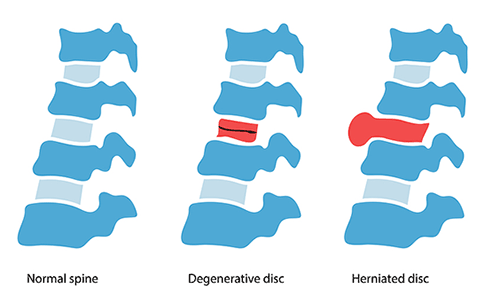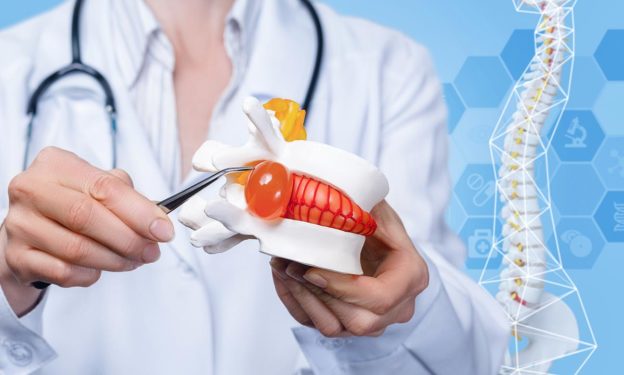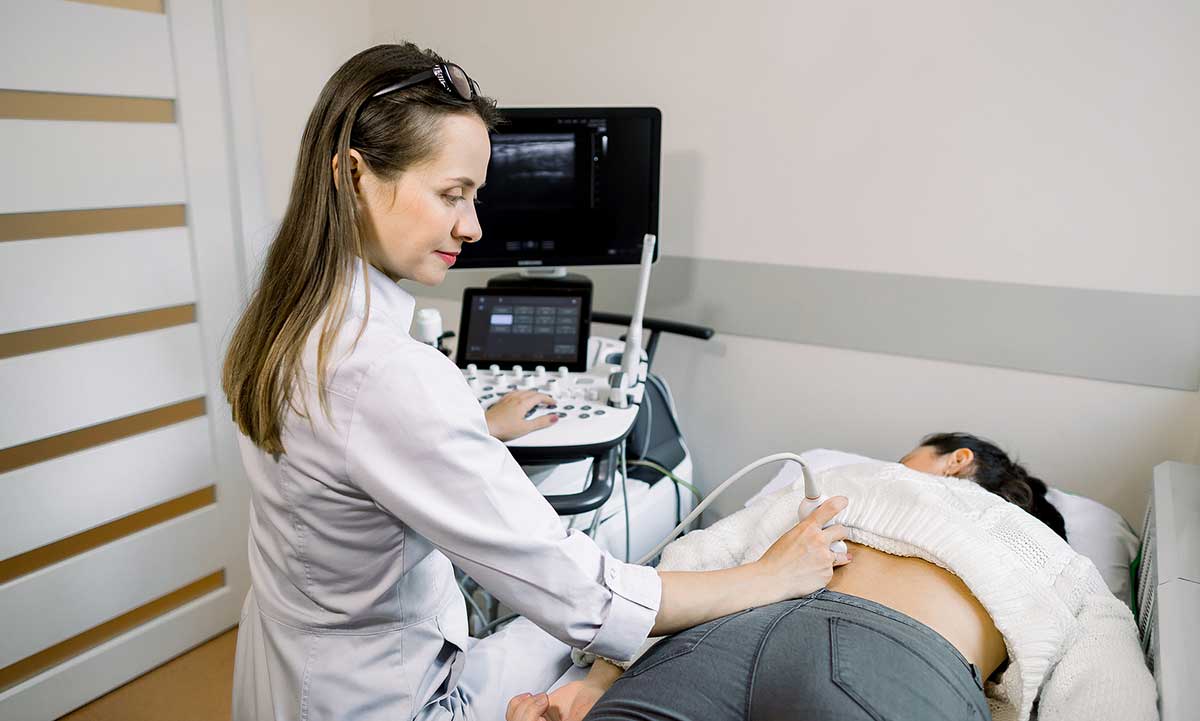Back problems like a herniated disc are incredibly common, especially for older adults, yet people often do not get the pain relief they need. Between 1 and 3% of adults suffer from a herniated disc each year. Learn about herniated disc treatment to get the pain relief you need to get back to your everyday life.
What Is a Herniated Disc?

Each spinal disc has a tougher exterior surrounding the soft gel-like material inside. Sometimes, the soft gel slips out past that exterior. This causes the disc to bulge or “herniate.” A herniated disc is sometimes called a slipped or ruptured disc due to its bulging appearance.
The main symptom caused by a herniated disc is severe pain. This pain may occur anywhere along your spine, though it is most common in the neck and lower back. Because the herniated disc irritates the nerves encased in the bony spine, it can also cause pain to shoot through the arms, buttocks, or legs. Many people describe this as a sharp, burning pain. For some people, symptoms may include tingling, numbness, or weakness in the arms or feet. This usually happens on one side of the body.
For over 25 years, people from all over the world have chosen Waismann Method as their opioid detox provider.
We know the challenges you face and the importance of creating a unique and personal experience for you right from the start.Call for Detox Options 1-800-423-2482
Technically, any disc in the spinal column may become herniated. However, this most commonly occurs for discs in the lower spine (lumbar spine). This makes herniated discs a leading cause of lower back pain.
A trip to the doctor for a herniated disc may involve a physical examination and medical history for most people. Imaging is typically not needed to diagnose a herniated disc. However, your doctor may want you to get a CT scan or MRI scan to confirm the diagnosis. These scans can show what part of the spine is affected by the herniated disc.
Opioid Medications as a Pain Management Strategy for Herniated Discs
Herniated discs are incredibly painful, and patients are understandably eager to get pain relief. Over-the-counter medications such as ibuprofen (Advil) or acetaminophen (Tylenol) may not be sufficient to relieve pain. The continuous pain leaves some patients wondering whether more potent painkillers like opioids might help.
While short-term use of opioids can help to relieve pain, they often cause additional problems that make them a poor option for people with herniated discs. Using opioids puts you at high risk for opioid tolerance and dependence. Opioid tolerance is a physiological condition in which your body becomes used to opioids and requires more to get the same pain-relieving effect it initially did. Opioid dependence is when your body physically adapts and changes to the constant presence of opioids. If the intake is suddenly discontinued, the opioid-dependent individual is likely to suffer from withdrawal syndrome.
A recent scientific report from researchers at Thomas Jefferson University studied the use of opioid painkillers for herniated discs. The study found that people given opioids for a herniated disc were significantly more likely to end up getting surgery for disc herniation. These same patients were also more than three times as likely to still be using opioids four years later compared to a non-opioid using group.
Opioids also do not address the underlying physical problem that causes disc herniation. In fact, taking powerful painkillers can sometimes cause people to remain more active than they should, making the injury worse. Focusing on strengthening the back and preventing herniation is the best way to get long-term relief.
Non-Pharmaceutical Herniated Disc Pain Relief Options
Non-pharmaceutical options may also help to relieve herniated disc pain. Consider discussing with your doctor the following choices for pain relief:
1. Rest
Often, the best treatment for herniated disc pain is to rest as much as possible. It takes time for your back to heal and for swelling to go down. If possible, take time away from work or other responsibilities, so you can avoid certain physical activities that might aggravate the condition. While some doctors recommend complete bed rest in some cases, it is important not to stay entirely immobile for more than 1 or 2 days. Discuss with your doctor the best type of movement to ensure that your joints and muscles continue to work properly.
2. Ice and Heat Therapy
Applying ice and heat to the affected area can help with a herniated disc. You might try switching between an ice pack wrapped in a towel and a heat pack warmed in the microwave to improve your symptoms.
3. Stretching
AskDoctorJo. Mar 23, 2016. Herniated Disc Exercises & Stretches. YouTube.
The goal of stretching exercises is to relieve pressure on your spinal nerve due to the herniated disc. For upper back pain, try gentle neck stretches. Gently move your head forward, allowing your chin to move toward your chest. Then, tilt your head backward, so you look toward the ceiling. Also, tilt your head so your ear moves toward your shoulder on each side. Repeat these stretches ten times, several times per day, to get relief.
For lower back pain, lie on your back and draw your knee toward your chest until you feel a stretch through your thighs and buttocks. Gently move your knee from one side to the other to stretch your outer thighs.
** These types of exercises are always best when overseen by a health care professional.
4. Physical Therapy
Physical therapy is beneficial for relieving pain. A physical therapist might recommend stretches and flexibility exercises to reduce inflammation and improve muscle strength. Increasing back muscle strength while improving motion is often a great way to minimize discomfort. Continuous PT can significantly help patients relieve pain, promote a healthy body weight and improve overall strength.
5. Ultrasound Therapy
Focused ultrasound therapy, also known as electrical muscle stimulation, is one of the most common physical therapy’ options for treating disc issues. This type of therapy sends ultrasound energy or electrical stimulation for immediate pain relief. Ultrasound is a non-invasive alternative option, low-cost, and can treat the desired target without damaging surrounding tissue.
6. Acupuncture
Acupuncture is part of Traditional Chinese Medicine that has been shown to provide pain relief for various medical conditions. Scientific evidence shows that acupuncture helps improve herniated disc pain. An experienced acupuncturist will insert tiny needles into specific places on your back. After 20 to 30 minutes, these needles are removed.
Conclusion
A herniated disc is a condition that occurs with one of the discs that sit between the vertebrae. This painful condition can occur in any part of the spine, and it can also irritate a nerve. Disc herniation is often a result of aging.
As you age, your discs become less flexible and more prone to damage even with minor effort, most commonly from lifting a heavy item and using your back muscles instead of your legs. The results are usually pain, numbness, and weakness on the arm or legs. Although the pain might be intense, surgery is generally not necessary.
There are several ways to manage the pain, as described above. In addition to immediate pain relief, it is essential to focus on preventing future injuries. Regular exercise, good posture, and maintaining a healthy body weight prevents recurrence of any disc problems. Additionally, please consider consulting with your doctor before starting any treatment or exercise routine to ensure the best and safest healing path.
Sources:
- NCBI: Herniated Lumbar Disc
- NCBI: Does Opioid Pain Medication Use Affect the Outcome of Patients with Lumbar Disk Herniation?
- Mayo Clinic: Herniated Disk
- HealthCMi: Acupuncture Herniated Disc Pain Finding
Written by Aurora Harklute
Aurora is a neuropsychologist and freelance writer with more than ten years of experience with a bachelor’s degree in human physiology, a master’s degree in cognitive psychology, and a Ph.D. in clinical psychology. Aurora writes for a variety of industries within the substance abuse and medical fields. She also specializes in the impact of substance use on mood and cognition.
Reviewed by Clare Waismann, Registered Addiction Specialist (RAS), Substance Use Disorder Certified Counselor (SUDCC), founder of Waismann Method® Advanced Treatment for Opiate Dependence and Domus Retreat®. Clare Waismann is an authority and expert on opioid dependence, opioid use disorder, substance dependence, detoxification treatments, detox recovery, and other topics covered on RapidDetox.com.







